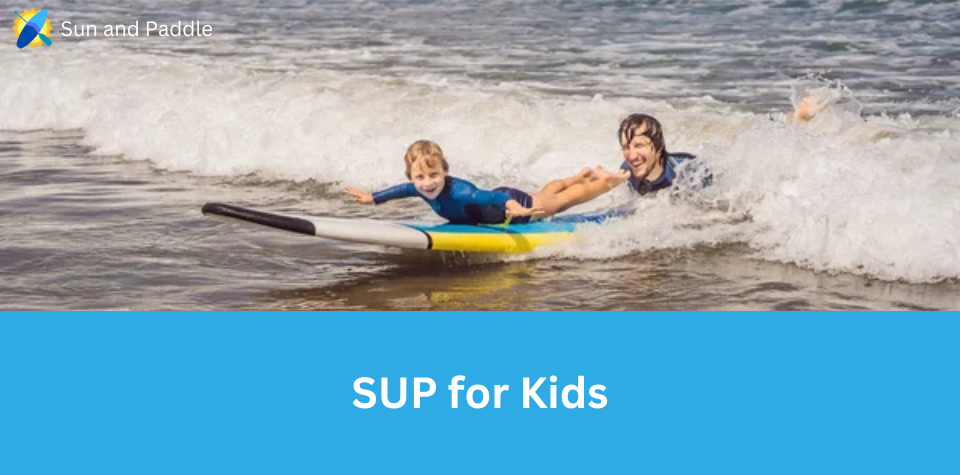Paddleboarding combines the excitement of water sports with a low-impact exercise that kids can enjoy while exploring lakes, rivers, and oceans.
Introducing children to stand-up paddleboarding (SUP) offers them a unique opportunity to develop balance, coordination, and strength, all while basking in the beauty of nature.
As an activity that can be both relaxing and physically demanding, paddleboarding has something for every young adventurer, whether they’re gliding serenely across a calm bay or riding the gentle swells of the sea.
For many kids, paddleboarding serves as an engaging way to experience the outdoors and learn about water safety. This sport encourages youngsters to become confident on the water and can also be a family-friendly activity, allowing for bonding time and the creation of cherished memories.
By starting children off with the right equipment, proper techniques, and a strong foundation in safety, they’re more likely to develop a lifelong passion for paddleboarding and a love for the great outdoors.
Key Takeaways
- Paddleboarding offers developmental benefits like balance and coordination.
- It promotes water safety and confidence in young paddlers.
- Beginning with proper instruction ensures a sustainable and enjoyable experience.
Benefits of SUP for kids
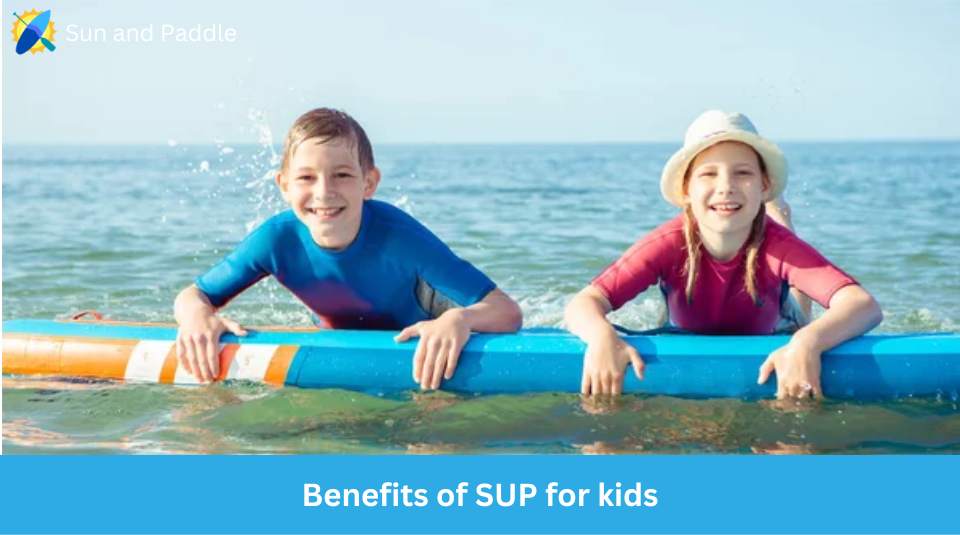
Stand Up Paddleboarding (SUP) offers children a range of benefits from physical to mental health improvements.
Paddleboarding encourages outdoor play, enhances fitness and balance, builds confidence, and can be a calming activity.
Spend More Time Outdoors
By engaging in SUP, your child gains the opportunity to enjoy nature and increase their time spent in fresh air and sunlight.
This activity encourages a connection with nature, potentially fostering a lifelong appreciation for the outdoors.
Improves Fitness & Endurance
Paddleboarding is an excellent full-body workout that enhances your child’s cardiovascular fitness.
It works a variety of muscle groups, including:
- Core muscles for stability
- Upper-body muscles for paddling
- Leg muscles for balance
Regular participation in SUP can lead to improved endurance over time.
Improves Balance And Coordination
SUP demands balance and coordination, which improves as your child learns to maneuver the paddleboard.
This activity teaches body awareness and can have cross-over benefits in other sports and everyday activities.
Builds Confidence
Learning and mastering new skills, such as standing and paddling on a SUP board, can significantly boost your child’s self-esteem. Each accomplishment on the board is a step towards increased confidence.
Stress Relief
Paddleboarding can be a meditative and relaxing experience that helps reduce stress levels in children.
The rhythmic nature of paddling coupled with being on the water can create a calming effect, promoting mental well-being.
You might notice that many of these benefits are the same as the benefits for SUP for all people.
Guide to Teaching Kids Paddleboarding
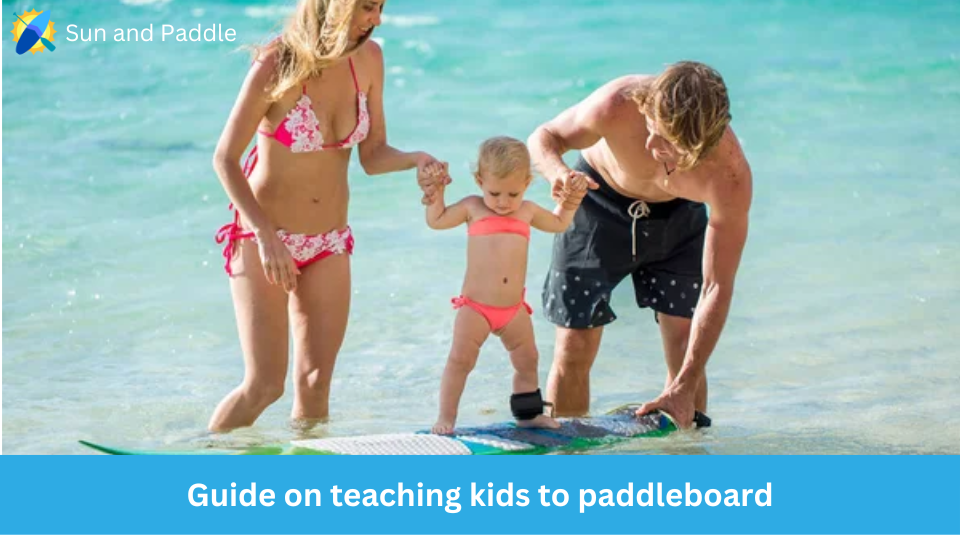
Introducing children to paddleboarding involves ensuring they can swim, familiarizing them with the equipment, starting on land, practicing in safe water conditions, and learning essential safety and paddling techniques.
Teach Them How To Swim
Before venturing into paddleboarding, confirm your child is a proficient swimmer. It’s crucial for safety on the water.
Enroll them in swimming lessons if needed, and always supervise them around water.
Get Comfortable On Your Board
Let your child familiarize themselves with the paddleboard on dry land. Show them how to balance by standing on the board and shifting their weight.
Explain the parts of the board: the deck, fins, and paddle.
Practice On Land First
Practice basic paddle strokes on land.
Teach them the forward stroke, reverse stroke, and sweep stroke. They can mimic paddling movements while standing beside the board to build muscle memory.
Start Off In Calm, Shallow Water
Choose a calm, shallow spot for their first attempt.
This allows for easier balance and a safe environment to fall and stand back up. Ensure there are no strong currents or waves.
Teach Them Paddling & Safety Tips
- Basic Paddle Strokes: Instruct them on how to hold the paddle with one hand on top and the other on the shaft.
- Safety Tips:
- Wear a Life Jacket: Always wear a life vest for safety.
- Leash: Attach the leash to ensure the board doesn’t drift away.
- Sun Protection: Apply sunscreen and wear a hat for UV protection.
Start Off Kneeling
Encourage starting on their knees to paddle.
This position offers greater stability and helps them gain confidence. Once comfortable, they can attempt to stand up one foot at a time, keeping their feet shoulder-width apart.
Important Safety Tips When Paddleboarding with Kids
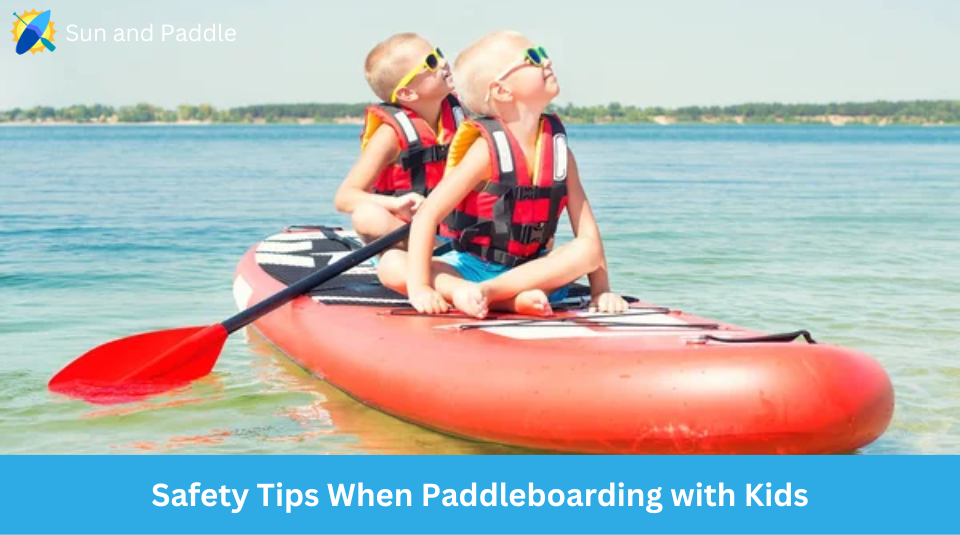
Paddleboarding with kids can be a delightful activity, but it’s vital to prioritize safety. Adhere to these specific tips to ensure a safe and enjoyable experience on the water.
Everyone Wears A PFD
- Personal Flotation Device (PFD): Ensure that both you and your child are wearing a US Coast Guard-approved PFD at all times.
- Check that the PFD fits snugly and is appropriate for your child’s weight and age.
Make Sure SUP Can Handle All Passengers
- Weight Capacity: Before you set out, confirm that your Stand-Up Paddleboard (SUP) is designed to support the combined weight of all passengers to prevent capsizing.
Double Check The Weather
- Weather Conditions: Always check the forecast for wind, waves, and storms.
- It’s best to paddle in calm, clear conditions especially when with children.
Dress Your Child In Suitable Clothing
- Clothing Choice: Opt for quick-drying, moisture-wicking fabrics and layers that can be easily adjusted for changing temperatures.
Wear Sunscreen, Even On Overcast Days
- Sun Protection: Apply a broad-spectrum sunscreen of at least SPF 30 to all exposed skin, and reapply every two hours or after swimming or sweating.
Run Through Emergency Scenarios With Them
- Prep Talk: Discuss potential risks and what to do in an emergency, such as falling off the board or getting separated.
- Practice safety drills before heading out.
What to Bring When Paddleboarding with Kids
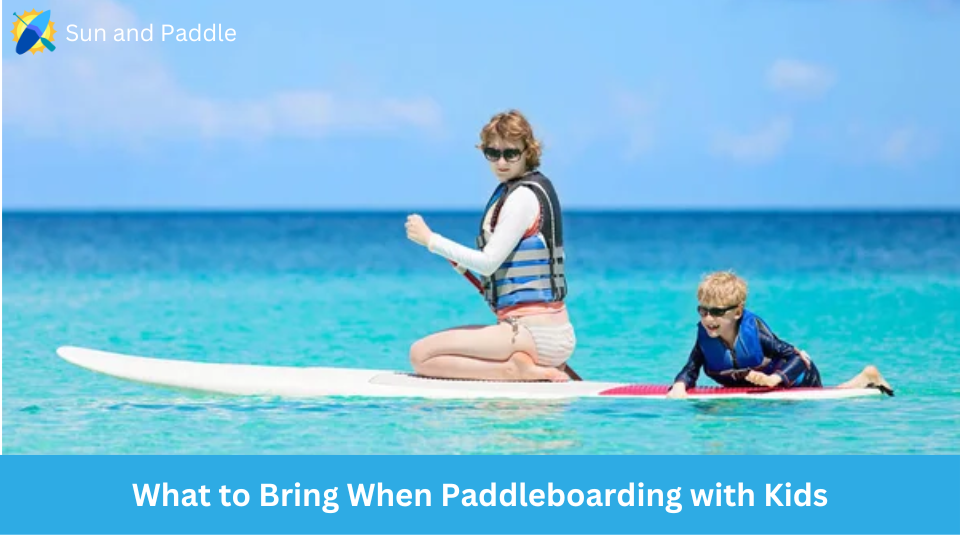
Young children, particularly beginners, could benefit from using the proper paddle boarding equipment. Shorter and broader boards improve their equilibrium, and the proper-sized paddle provides the most support. You’ll also need a means to transport your equipment; the most recommended method is a paddleboard roof rack.
PFDs
A functional life jacket may be the most essential item you can bring with you. A life jacket can keep you secure in the water while you are still learning how to paddle board. Even if you know how to swim, you should still wear a life jacket due to constantly altering conditions and other factors that may affect your safety. Whether you like it or not, being in open water means you are susceptible to sudden weather changes and cramping that could place you in danger. We recommend that even experienced paddle boarders always don a life jacket.
Personal flotation devices were mentioned in the initial recommendations for paddle boarding with an infant, but they are so crucial that it is necessary to mention them again. On a paddle board or in the water, your neonate or child should always wear a personal flotation device (PFD).
In all environments, these are essential for children, particularly non-independent swimmers. It is debatable whether or not parents should don PFDs, but if in doubt, it is probably best to do so. When we visit our local river, we do not wear them because we are both experienced swimmers, the river is not rough, and we always wear leashes that secure us to our boards, which are essentially large buoyancy aids. However, we do wear them in other settings.
Paddleboard Leashes
You may believe that a SUP leash is merely an accessory, but it is significantly more important than that. An SUP leash is safety equipment that can help you remain attached to your board and also serves as a floatation device in the event that you tumble into the water. If the leash is too long, it can become entangled in the current or any floating detritus in the water.
As with the life vest, you need the leash for safety. When you enter open water, you must have all the necessary safety apparatus, especially because you are a beginner. Even in flatwater, there is too much uncertainty the instant you step on your board. Therefore, ensure you have a leash and are under close supervision the first time you paddle board in water.
Always wear a leash to maintain your connection to your board. Most individuals, upon falling, send the board away from themselves. Or, if a strong wind is present, the board will rapidly move away from you if you are not wearing a leash. Paddleboards are effective floatation devices. Without a leash, however, your board will rapidly float away, leaving you to tread water. The majority of individuals wear leashes around their ankles. Leashes do not impede movement, and you will forget you are wearing one over time.
There are two primary varieties of leashes. A tether with a coil and a straight leash. A coil tether is ideal for the majority of paddlers. A coil leash will remain out of the way on the rear of the board and will not drag in the water behind you. Surfing cords are typically straight.
Waterproof Bag for Essentials
As their name implies, dry bags keep your possessions dry. Bring a change of clothing for the child in the event that he or she falls into the water. Additionally, a waterproof purse will keep your valuables dry. If the bag collapses into the water or if water splashes onto the SUP, you won’t have to worry about your phone or camera swimming away. You can use your dry bag to separate your wet clothing from the rest of your belongings. Consequently, you should purchase one or two because they will prove useful.
Food & Water
Even if you don’t intend to be out on the water for too long, you should carry plenty of water and snacks. You do not want to be on the water with a child who is famished or thirsty. Both of you will experience frustration as a result. Bring items that they enjoy, and if you don’t have a cooler, bring something that won’t dissolve in the heat.
Sunscreen
Sunscreen is required because sunburns are unpleasant, and they are especially painful for young children. In addition to sunscreen, have your child wear a hat and protective clothing. Reapply sunscreen frequently throughout the day, particularly after swimming.
Inflatable Paddleboards
A quality stand-up paddleboard, ideal for family paddling, is also required. It should be spacious enough to accommodate you, your infant, and all of your belongings. Remember that children may move the SUP significantly, so stability is crucial. Inflatable paddle boards are also recommended because they are gentler than hard boards. Your infant is less likely to sustain an injury should they fall and strike it.
Obtain a wide, stable paddle board with a substantial deck cushioning. The pads are typically soft and will provide all passengers with a comfortable place to stand or rest. Additionally, they provide traction so that nobody will slide off the SUP board when it is damp. For your luggage, you should also consider a board with elastic storage. Additionally, additional D-rings are useful if you wish to attach a SUP refrigerator or kayak seat. Inflatable SUP boards are good options for kids.
There are many other accessories to bring paddleboarding, including bags, wet suits and straps.
5 Best Paddleboards for Kids
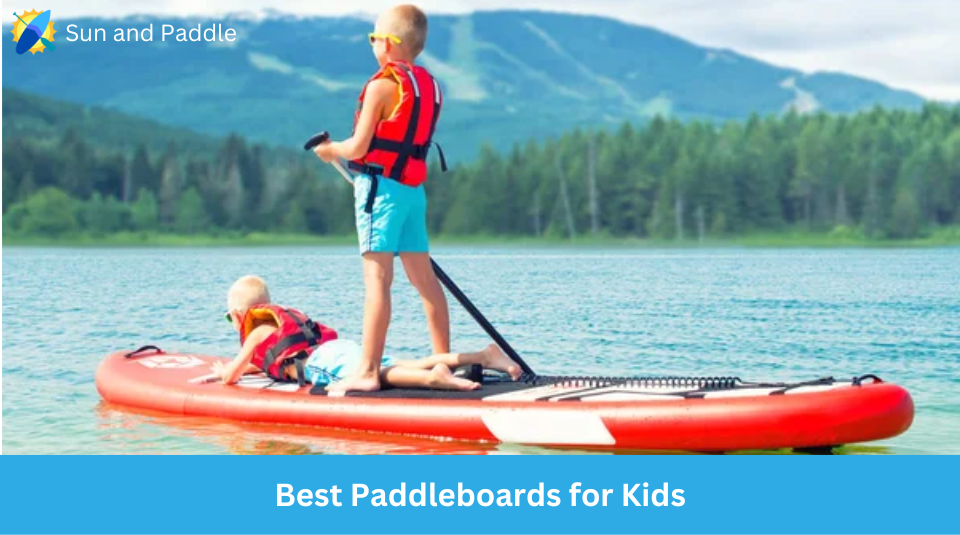
Due to their durability and leniency, inflatable paddleboards are the best choice for children. When rigid paddleboards collide with a rock, they dent or scrape, whereas an inflatable board simply rebounds off. This forgiveness helps prevent harm to both the board and the paddler. On an inflatable board, falls are much gentler than on a rigid board. Additionally, foam boards provide this suppleness.
Thurso Adept 108 Youth iSUP
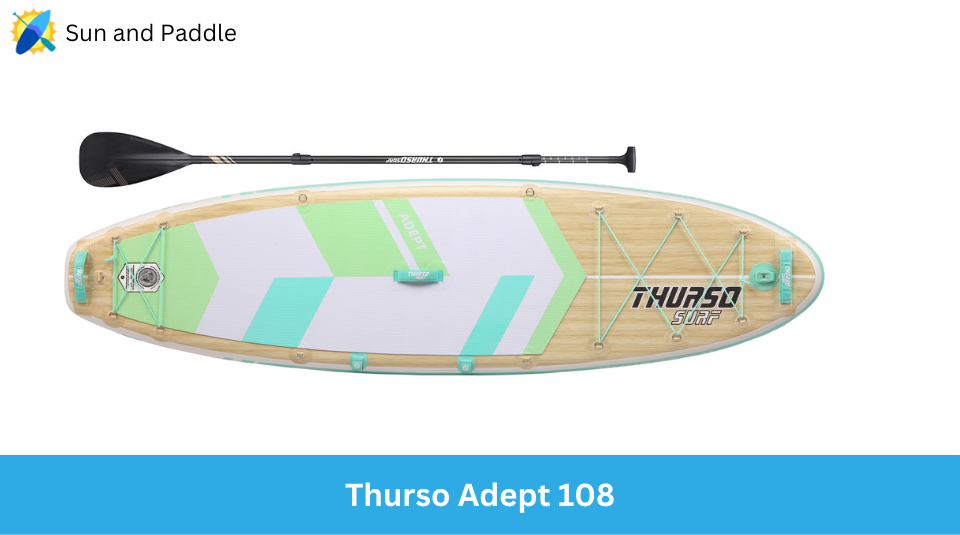
The Thurso Adept 108 is designed to bridge the distance between the Thurso Prodigy Jr. and Thurso Waterwalker. The Prodigy Jr. is an iSUP designed particularly for younger children (up to 80lb), whereas the Adept is designed for older children and adolescents (up to 150 lb). The longer length provides more stability for taller children without exceeding what is suitable for paddling. The Adept utilizes the same construction techniques and materials as the full-sized Waterwalker to ensure optimal performance in the water.
The Thurso Adept features the same quality construction and materials as the acclaimed Thurso Waterwalker paddleboards for adults. The Adept’s rails are reinforced with carbon fiber for increased rigidity and durability. All of Thurso Surf’s iSUPs feature superior construction quality. All of their inflatable paddleboards are constructed with woven drop stitch fabric and double-layer PVC for the deck and hull.
Encircling the standing area on the sidewalls of the Adept are a double-layer PVC rail and a carbon fiber rail reinforcement strip. The carbon fiber fabric is less flexible than the PVC material and prevents the paddleboard from bulging during use, thereby increasing the overall rigidity of the board. Additionally, the rails are lined on the top and bottom with additional PVC reinforcement strips, which prevent the rails’ edges from snagging on anything and potentially wearing away the board.
The triple-layer rails and dual-layer top and bottom make the Adept extremely abrasion resistant. Smaller paddlers may have difficulty carrying a paddleboard over extended distances and may drop or drag it more frequently. This increased abrasion resistance means there will be fewer punctures to repair and the SUP will last longer. This does contribute a small amount of weight to the Adept, but the board’s overall smaller size and layers of woven fabric keep it at just 19 pounds.
For novice adolescent paddlers, the recommended rider weight for the Thurso Adept is 120 pounds. With the same construction as the full-size Waterwalker series, the Adept has a significantly higher carrying capacity, allowing even older tweens to use it and transport everything they need for a day on the water.
Nautical Kids Inflatable SUP
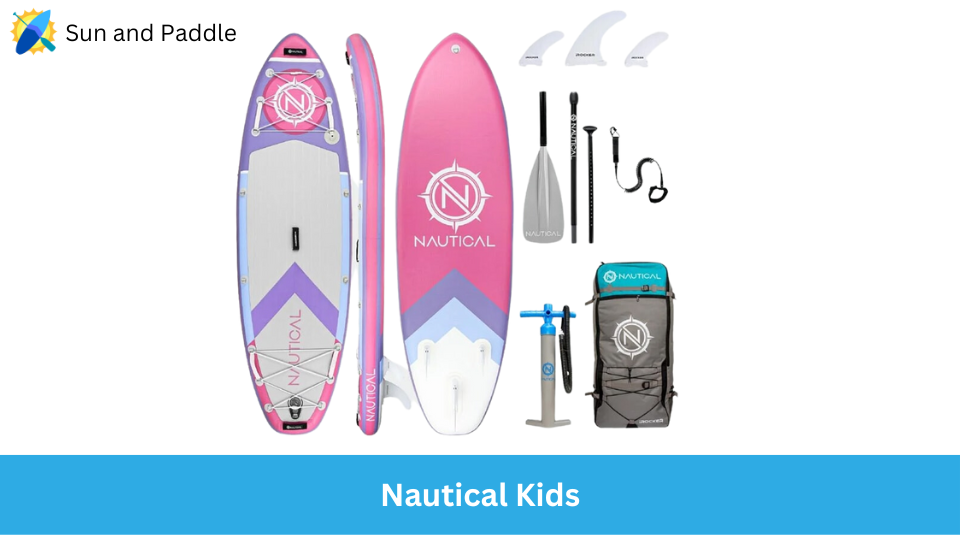
The Nautical Kids iSUP by iRocker has the greatest stability and volume of all the inflatable paddleboards for children that we have reviewed. The 32″ width provides an incredible amount of stability, while the full 6″ depth maintains ample volume for a high weight capacity. The Nautical Kids iSUP is an excellent option for two smaller children to share, for an adult to recline and paddle with their child, and as a solo paddleboard for growing children.
The Nautical Kids iSUP is constructed with the same double-layer PVC as the full-size Nautical iSUPs. This enduring structure strikes a balance between stiffness, weight, and cost. The double-layered rails and rail edge reinforcement sections of the Nautical Kids iSUP.
The Nautical Kids iSUP is a scaled-down variant of iRocker’s Nautical iSUPs. The Kids version begins with a 6″ thick drop stitch interior with two layers of PVC adhered to the deck and hull. Two additional PVC layers secure the airtight chamber and enhance the board’s overall rigidity and durability.
Two additional lengths of PVC material cover the top and bottom edges of the rails. These rail reinforcement strips safeguard the board’s edges, which are most susceptible to dings, scuffs, and pulls during transportation and use on the water.
The double-layer PVC material strikes an excellent balance between rigidity, durability, weight, and cost. The Nautical Kids iSUP is extremely lightweight at only 17.2 lbs, without forsaking durability, which is ideal for a kid’s paddleboard. Compared to thinner kids’ paddleboards, the Nautical Kid’s iSUP’s larger dimensions not only increases its stability, but also its stiffness. This ultimately results in greater stability and efficacy on the water than a thinner, more flexible board.
Gili Cuda 8’ / 9’ Inflatable SUP for Kids
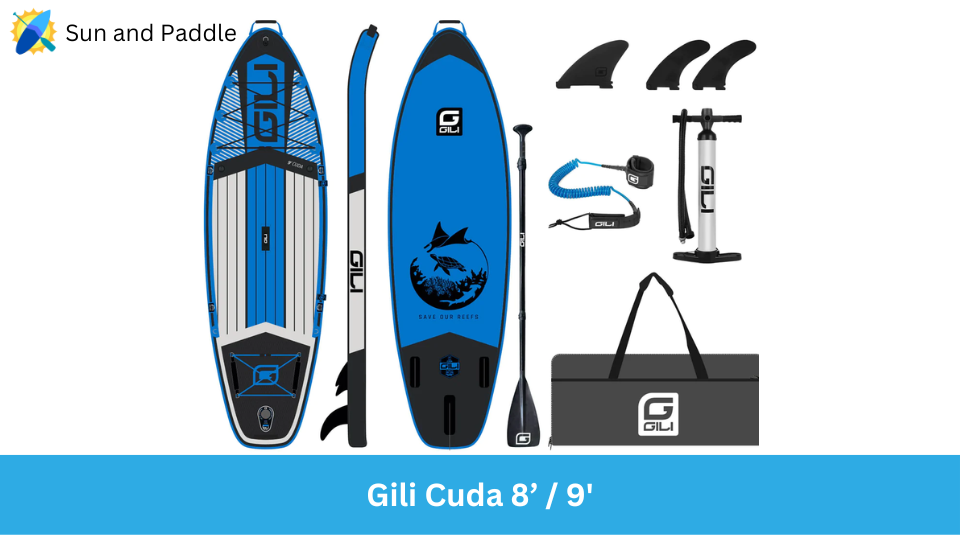
The Gili Cuda kid’s iSUP is a feature-rich, budget-friendly inflatable paddleboard that is offered in two sizes. The 8′ Cuda is ideal for children under 10 years old, while the 9′ Cuda is ideal for children 9-14 years old. Both versions of the Cuda have the same width, depth, and feature set, which provides a great deal of flexibility.
The superstructure and hull of the Gili Cuda have a single layer of PVC laminated to an internal drop stitch core. This solitary layer of PVC is quite resilient on its own while keeping the board’s weight to a minimum. Cuda’s rails or sides are wrapped in two layers of PVC to enhance their overall and torsional rigidity. The rails are the most susceptible parts of an iSUP because they are the most likely to be dropped, dragged, or impacted. The dual-layer PVC is highly resistant to regular use and the occasional mishap.
In addition to having double-layer rails, the Cuda has two reinforcement sections on the top and bottom of each rail layer. This adds an additional layer of PVC material and protects the margins of the rail layers from snagging. The diminutive size of the Cuda and the diminutive size of its paddlers significantly increases the perceived stiffness of the watercraft. This also improves the Cuda’s efficiency and stability.
Bote Flow Aero Kids Inflatable SUP
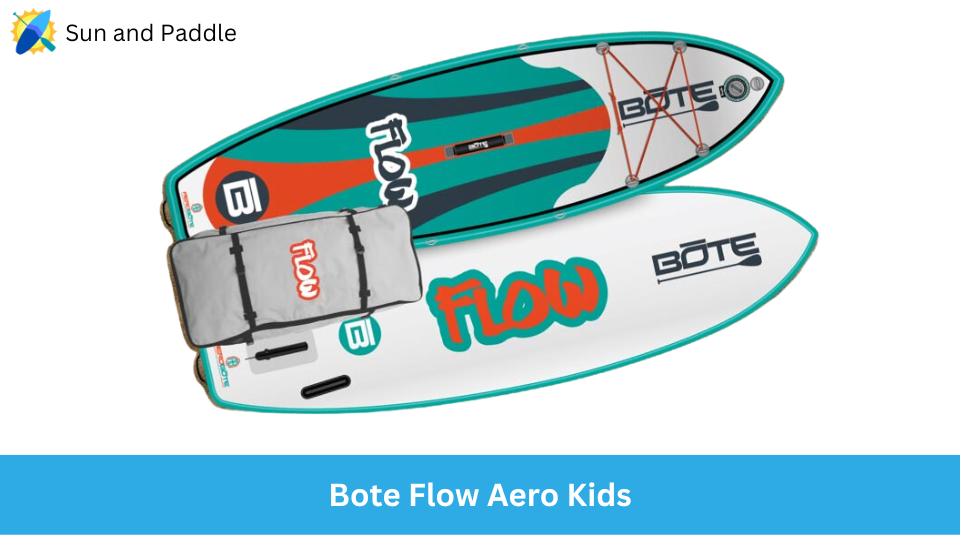
For children weighing less than 90 pounds, the Bote Flow Aero is an easy-to-use, all-around inflatable stand-up paddleboard. Even though the flow has few on-board features, it is still a versatile option for a day on the water with your children. AeroBote construction offers exceptional durability and performance, allowing the Flow to evolve with your paddling protégé.
AeroBote and AeroUltra are the two distinct types of construction for Bote’s inflatable paddleboards. AeroUltra’s superstructure and hull are constructed from a single layer of PVC to reduce weight and cost. AeroBote’s superstructure and hull are constructed with two layers of PVC to increase rigidity and durability. The Bote Flow employs the AeroBote dual-layer construction. The two layers of PVC material significantly increase the rigidity of the board, resulting in improved stability and performance on the water. The Flow is distinguished from other Bote inflatable SUPs by its 4.5″ girth. The thinner board will sit lower in the water, increasing stability and making it simpler for children to remount after falling off.
The top and bottom are sealed with an inner rail layer that has been heat-pressed. Using temperature-activated glue, heat pressing creates a stronger bond than conventional adhesives. The board is then enclosed with a second layer of PVC to increase its rigidity and durability. Finally, a PVC strip is adhered to the top and bottom of the rail to reinforce its edges. This results in a highly durable inflatable paddleboard, which is ideal for children who are more likely to occasionally jostle, drop, or drag the SUP.
Sea Gods ASR
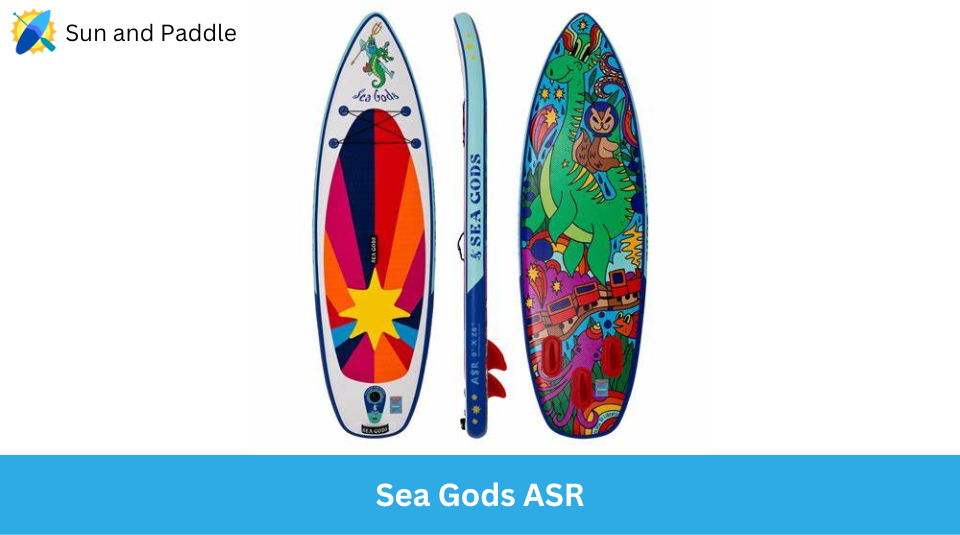
The Sea Gods ASR is a smaller kids iSUP measuring 8′ in length and 28″ in width, but it has the same superb construction as the Sea Gods Diatom. The fusion PVC shell, high-density drop stitch, and heat-molded seams allow you and your child to inflate the ASR to a maximum of 20 PSI for maximum rigidity which aides in stability. Although it is on the smaller side for this list, it is suitable for children up to 120 pounds and comes with a lifetime warranty from Sea Gods.
The Sea Gods Family has been working on this board since our four-year-old daughter first stood on her own and paddled to shore. Olivia Di Liberto (Chillivia), an artist, visited our deck to meet our children and sketched their innermost desires. This board will fulfill all of your child’s SUP requirements.
This complete set, handcrafted from premium materials and supplied with the highest quality accessories, is adventure-ready whenever you are. Peace of mind is yours with Sea Gods’ perpetual warranty. Three integrated neoprene fins make it easy for your child to enter and exit the water. The paddle is an adjustable, durable aluminum-nylon paddle in the ideal size for children that will grow with them.
This board will be easy for your little SUP star to carry, paddle, and maneuver, and if they get tired and want to hop back on your board, it will be simple to hitch up and tow behind your board until they are ready for independence once more.
FAQs
Before you introduce your child to paddleboarding, some key questions need to be addressed to ensure safety and enjoyment. These cover age suitability, safety precautions, equipment size, ideal conditions, and recommendations for the most appropriate types of paddleboards for young paddlers.
At what age is it generally safe for children to begin paddleboarding?
Children can start paddleboarding as early as age six, but each child’s readiness may vary based on balance, swimming ability, and comfort in the water.
What safety measures should be taken when paddleboarding with children?
You should always ensure your child wears a properly fitting life jacket.
Additionally, it’s important to paddle in safe, calm waters and to stay close to them at all times.
How does a child’s size or weight affect the type of paddleboard they should use?
A child’s size and weight will determine the volume and length of the paddleboard.
Smaller, lighter children require boards with less volume and a shorter length for stability and maneuverability.
Can children use adult-sized paddleboards, or do they require kids’ models?
While children can use adult-sized paddleboards, it’s often easier for them to learn on kids’ models, which are lighter and easier for them to handle.
What are the best conditions for taking a child paddleboarding for the first time?
Ideal conditions for a child’s first time paddleboarding include calm, flat water, little to no wind, and warm weather to prevent hypothermia.
Are there specific types of paddleboards that are more suitable for children?
Yes, there are paddleboards designed for children. These are typically shorter, lighter, and narrower, making it easier for them to balance and paddle.

